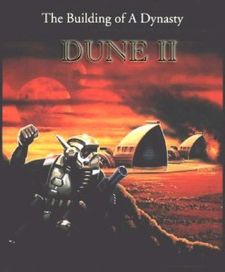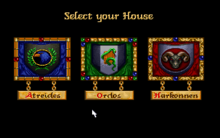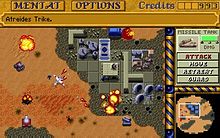- Dune II
-
This article is about the computer game. For Frank Herbert's sequel to his novel Dune, see Dune Messiah. For the MUSH, see Dune II (MUSH).
Dune II 
Developer(s) Westwood Studios Publisher(s) Virgin Interactive Designer(s) Joseph Bostic,
Aaron E. Powell,
Brett SperryProgrammer(s) Joseph Bostic (lead),
Mike LeggVersion 1.07
Team bug fix (2009)[1]Platform(s) Amiga, DOS, RISC OS, Genesis/Mega Drive Release date(s) 1992 (DOS)
1993 (Amiga)
1993 (Mega Drive/Genesis)Genre(s) Real-time strategy Mode(s) Single player Media/distribution Floppy disks, CD-ROM or Cartridge Dune II: The Building of a Dynasty (retitled Dune II: Battle for Arrakis in Europe and for the Mega Drive/Genesis port) is a Dune computer game released in 1992 by Westwood Studios. It is based upon David Lynch's 1984 movie Dune, an adaptation of Frank Herbert's science fiction novel of the same name.
While not necessarily the first real-time strategy (RTS) game (elements of which previously appeared in Stonkers, The Ancient Art of War, Command HQ, and particularly Herzog Zwei), Dune II established the format that would be followed for years to come.[2][3] As such, Dune II was the archetypical "real-time strategy" game. Striking a balance between complexity and innovation, it was a huge success and laid the foundation for the coming Command & Conquer, Warcraft and Starcraft series, and many other RTS games.
Contents
Story
Emperor Frederick IV of House Corrino is desperate for the harvesting of the valuable drug melange (also known as 'the spice'), only found on the planet Arrakis, to pay off all of his debt incurred on internecine wars with family members. To achieve this, he now offers the sole governorship of Arrakis to the House (Atreides, Harkonnen, and Ordos) which delivers the most spice for him. War begins as deputations from all three Houses arrive on Arrakis.
The player is a military commander from a House of their choice. In the first few missions the objective is to successfully establish a base on an unoccupied territory of Arrakis, to harvest spice and defend against intruders. Later, when the three Houses divide Arrakis among them, the player has to assault and capture enemy territories. When the player dominates Arrakis on the world map, the two other enemy factions ally against their common enemy. The ultimate final showdown is the battle among the player's House up against three enemy sides, among them Frederick's forces the Sardaukar (an unplayable elite force whose heavy infantry are particularly powerful). The final cutscene is different for each House, in consonance with their very disparate world views.
Gameplay
The player takes the role of a commander of one of three interplanetary houses, the Atreides, the Harkonnen or the Ordos, with the objective of wresting control of Arrakis from the two other houses. House Ordos is not featured in the Dune novels and is mentioned only in the non-canon Dune Encyclopedia. The basic strategy in the game is to harvest spice from the treacherous sand dunes using a harvester vehicle, convert the spice into credits via a refinery and to build military units with these acquired credits in order to fend off and destroy the enemy.
The game map initially starts with a fog of war covering all area which is not covered by the player's units range of view. As the units explore the map, the darkness is removed. Unlike later games such as Warcraft II: Tides of Darkness, the fog of war is lifted forever with initial exploration, it does not become dark once more when units leave the area.
In addition to enemy incursions, there are other dangers; like the marauding and gigantic sandworm, capable of swallowing vehicles and infantry whole but only capable of moving through sand. The player can only build on rocky terrain, but must build concrete foundations before to avoid deterioration of the structures due to the harsh weather conditions although in general, structures will gradually decay over time regardless of the presence of those concrete slabs due to the aforesaid weather conditions. Spice fields are indicated by orange coloration on the sand, darker orange indicating high concentration. Some spice may be concealed as bumps on the terrain (a 'spice bloom') that become spice fields when they are shot at, or when a unit runs over them (the unit is destroyed in the ensuing 'spice blow').
The player is presented a map of the planet Arrakis before most missions, where he can choose the next territory to play in among two or three. This affects primarily the enemy house fought in the next mission, as all missions except the first two require the complete destruction of the enemy. Nine territories must be fought, irrespective of house, to reach the endgame.
Some key elements that first appeared in this game, but would later appear in many other RTS games, include:
- A world map from which the next mission is chosen
- Resource-gathering to fund unit construction
- Simple base and unit construction
- Building construction dependencies (technology tree)
- Mobile units that can be deployed as buildings
- Different sides/factions (the Houses), each with unique unit-types and super weapons
- A context-sensitive mouse cursor to issue commands (introduced in the Mega Drive/Genesis version)
Completing higher missions gives authorization to use improved technology and higher-order weaponry unique to each House, ensuring varied game play. For example, House Harkonnen may be able to construct their Devastator tanks with heavy armor and ordnance but cannot build the similarly impressive Atreides Sonic Tank. The Ordos have access to the Deviator - a specialized tank firing a nerve gas that switches the allegiance of targeted units to Ordos for a limited period of time. The three Houses also are restricted in their production capabilities—House Ordos cannot build Atreides-style trikes, instead making the faster "Raider" trikes, while House Harkonnen constructs heavier but more expensive quad bikes.
A player can gain access to other Houses' special units by capturing an enemy Factory and manufacturing the desired units at the captured Factory (House Atreides' Heavy Vehicle Factory for Sonic Tank, House Ordos' Light Vehicle Factory for Raider trikes, House Ordos' Heavy Vehicle Factory for Deviator tanks, or House Harkonnen's Heavy Vehicle Factory for Devastator tanks). Note that a Deviator not owned by House Ordos still switches control of targeted units to House Ordos, and not to the side that owns the Deviator. Apparently Westwood was aware of this feature, since capturing a Sardaukar Heavy Vehicle Factory allows the player to build both the Sonic Tank and Devastator, but not the Ordos Deviator.
Buildings may only be built in rocky zones and connected to another existing building, and are the same for all houses. To protect them from constant wear, the player must first place concrete slabs in the construction areas. Production buildings can be upgraded at a cost several times, allowing the production of more advanced units or buildings.
The final prize for the commander is the building of the House Palace from where superweapons may be unleashed on opponents in the final closing chapters of the game. The House Harkonnen superweapon is a long-range powerful but inaccurate finger of missiles called the Death Hand, whereas House Atreides may call upon the local Fremen infantry warriors, over which the player has no control, to engage enemy targets. House Ordos may unleash a fast-moving Saboteur whose main purpose is the destruction of buildings.
The AI of Dune II was one of the first used in RTS games, and while better than that of Herzog Zwei, it has various drawbacks. Examples include only attacking the side of the player's base facing its own, general inability to perform flanking maneuvers, and not rebuilding defenses.[4] Recent research into the game's engine by fans revealed that the AI is in fact capable of more advanced strategy, but that a large part of these capabilities is unused due to consistently repeated errors in all of the game's mission scripts.[5]
Development
Westwood Studios co-founder and Dune II producer Brett Sperry said in 2008 that "The inspiration for Dune II was partly from Populous, partly from my work on Eye Of The Beholder and the final and perhaps most crucial part came from an argument I once had with Chuck Kroegel, then vice president of Strategic Simulations Inc ... The crux of my argument with Chuck was that wargames sucked because of a lack of innovation and poor design. Chuck felt the category was in a long, slow decline, because the players were moving to more exciting genres ... I felt that the genre had a lot of potential – the surface was barely scratched as far as I as [sic] concerned, especially from a design standpoint. So I took it as a personal challenge and figured how to harness realtime dynamics with great game controls into a fast-paced wargame."[6]
Other influences cited by Joseph Bostic (also known as Joe Bostic), the co-designer and lead programmer, and Mike Legg, one of the game's programmers, include the turn-based strategy games Military Madness (1989) and Civilization (1991), and particularly the real-time strategy game Herzog Zwei (1989) on the Sega Mega Drive console. According to Bostic, a "benefit over Herzog Zwei is that we had the advantage of a mouse and keyboard. This greatly facilitated precise player control, which enabled the player to give orders to individual units. The mouse, and the direct control it allowed, was critical in making the RTS genre possible.”[7]
Versions
Originally released for DOS in 1992, Dune II was one of the first PC games to support the recently introduced General MIDI standard. Game-audio was programmed with the middleware Miles audio library, which handled the dynamic conversion of the game's MIDI musical score, originally composed on the Roland MT-32, to the selected soundcard. At initial release, the game's setup utility lacked the means to support separate output devices for the musical-score and speech/sound-effects. This limitation was frustrating to owners of high-quality MIDI-synths (such as the Roland Sound Canvas), because users could not play the game with both digital sound-effects (which MIDI-synths lacked) and high-quality MIDI score. Westwood later published a revised setup utility to enable users select a different soundcard for each type of game audio: digital-speech, music, and sound effects.
In 1993, it was ported to Amiga and Mega Drive/Genesis. Two years later it was also brought to the Archimedes and Risc PC range of RISC OS computers.
The Amiga floppy disk port is nearly identical in interface and game play to the PC version, albeit with less detailed graphics and frequent disk swapping (the game uses 5 disks). Save games are stored on a specially formatted disk and the game could also be installed to hard drive. In Amiga version the player is limited to 32 units, but patches exist to allow the full 255 units to be created and managed.
The Mega Drive/Genesis port has fairly different building and unit graphics, a full-screen menu-less user interface suited for gamepad control, and no save game support, relying on access codes for accessing each level. Other additions include a music test option and a tutorial that replaces the mentat screen. Several ideas from this version, including the music track listing and the replacement of sidebar command buttons by a context-sensitive cursor, were used in Westwood's next strategy game, Command & Conquer.
Reception
When the Amiga version of Dune II was released in 1993, it was met with positive reviews. CU Amiga magazine rated the game highly with 85%, praising the smooth gameplay and controls.[8] Dune II received Amiga User International's Game of the Month award when it was reviewed in September 1993.[9]
Legacy
Dune II was one of the most influential games in the real-time strategy genre, particularly in Westwood's own Command & Conquer series.[10] Though not every feature was unique, its specific combination of a fog of war, mouse-based military micromanagement, and an economic model of resource-gathering and base-building became the hallmark of the RTS genre. It served as the template for subsequent real-time strategy games.[2] Chris Taylor has stated that Dune II and Command & Conquer were great inspirations, driving him to leave Electronic Arts to create Total Annihilation.[11]
Dune II also led to direct sequels: Westwood released a semi-remake for Windows in 1998 as Dune 2000, along with a PlayStation port in the same year. Westwood subsequently released Emperor: Battle for Dune in 2001.
Remakes
- Dune 2: The Golden Path (multiplayer remake for Windows/Linux/Mac)
- Dune II: The Maker
- Dune Legacy (singleplayer/multiplayer remake for Windows/Linux/Mac)
- OpenDUNE, an open source re-creation of Dune II
References
- ^ MrFlibble (2009-03-29). "Dune 2 v1.07 Fix". dune2k.com. http://forum.dune2k.com/smf.php?showtopic=20168. Retrieved 2011-03-28. "This patch is designed to fix some errors in Dune II v1.07, first and foremost the so-called team bug (an internal syntax error that prevented the AI from assembling attack teams of combat vehicles), as well as a couple of other issues."
- ^ a b Bob Bates. Game Developer's Market Guide, p. 141, Thomson Course Technology, 2003, ISBN 1-59200-104-1.
- ^ Geryk, Bruce (19. Mai 2008). "A History of Real-Time Strategy Games: Dune II". gamespot.com. http://www.gamespot.com/gamespot/features/all/real_time/p2_02.html. Retrieved 2011-01-04. "[...] a game that is largely credited with revolutionizing the strategy genre [...]"
- ^ Brian Schwab.AI Game Engine Programming, p. 107, Charles River Media. ISBN 1-58450-344-0.
- ^ "Dune II team bug", FED2k forums, May 28, 2009.
- ^ "The Making of... Dune II". Edge. Next-Gen.biz. December 9, 2008. http://www.next-gen.biz/features/making-dune-ii. Retrieved July 27, 2011. "Herzog Zwei was a lot of fun, but I have to say the other inspiration for Dune II was the Mac software interface. The whole design/interface dynamics of mouse clicking and selecting desktop items got me thinking, ‘Why not allow the same inside the game environment? Why not a context-sensitive playfield? To hell with all these hot keys, to hell with keyboard as the primary means of manipulating the game!"
- ^ "The History of Command & Conquer". NowGamer. Archived from the original on 26 June 2011. http://webcache.googleusercontent.com/search?q=cache:6gTgCIHU6O4J:www.nowgamer.com/print/feature/184+Louis+Castle+herzog+zwei&cd=5&hl=en&ct=clnk&gl=uk. Retrieved 5 September 2011.
- ^ Gill, Tony (July 1993). CU Amiga review: Dune II. EMAP.
- ^ "Amiga User International review:Dune II". Amiga User International (AUI Limited). September 1993.
- ^ Porter, Will (2008-02-28). "Command & Conquer - Origins". ComputerAndVideoGames.com. http://www.computerandvideogames.com/article.php?id=183584. Retrieved 2008-04-02.
- ^ Tracy Fullerton, Chris Swain, Steven Hoffman,Game Design Workshop,p. 377, CMP Books, 2004, ISBN 1-57820-222-1
External links
- Dune II: The Building of a Dynasty at MobyGames
- Dune2k.com Wiki
- Dune II: The Building of a Dynasty guide at StrategyWiki
- GameSpy Hall of Fame
Dune video games Categories:- 1992 video games
- Amiga games
- Cancelled Super Nintendo Entertainment System games
- Cancelled Game Boy games
- Cancelled PlayStation games
- DOS games
- Dune games
- Real-time strategy video games
- Science fiction video games
- Sega Mega Drive games
- Video game sequels
- Westwood Studios games
Wikimedia Foundation. 2010.


